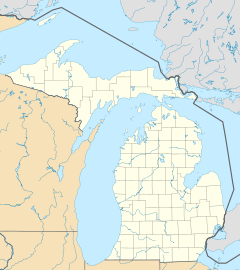Ferrysburg, Michigan facts for kids
Quick facts for kids
Ferrysburg, Michigan
|
||
|---|---|---|
| City of Ferrysburg | ||
|
||
| Nickname(s):
The Ottawa Peninsula, A Tri-Cities Community
|
||

Location within Ottawa County
|
||
| Country | United States | |
| State | Michigan | |
| County | Ottawa | |
| Settled | 1857 | |
| Incorporated | 1963 | |
| Government | ||
| • Type | Council–manager | |
| Area | ||
| • Total | 3.59 sq mi (9.30 km2) | |
| • Land | 2.99 sq mi (7.74 km2) | |
| • Water | 0.60 sq mi (1.55 km2) | |
| Elevation | 623 ft (190 m) | |
| Population
(2020)
|
||
| • Total | 2,952 | |
| • Density | 987.29/sq mi (381.17/km2) | |
| Time zone | UTC-5 (EST) | |
| • Summer (DST) | UTC-4 (EDT) | |
| ZIP code(s) |
49409
|
|
| Area code(s) | 616 | |
| FIPS code | 26-27960 | |
| GNIS feature ID | 0625927 | |
Ferrysburg is a city located in Ottawa County, Michigan. It's in the state of Michigan in the United States. In 2020, about 2,952 people lived here.
Ferrysburg is known as "The Ottawa Peninsula." It is also part of a group of nearby towns called the "Tri-Cities Community."
The city is surrounded by other towns and natural features. Spring Lake Township is to the north and east. The village of Spring Lake is across Spring Lake. The city of Grand Haven is across the Grand River to the south. To the west, you'll find the big Lake Michigan.
Major roads like US 31 and M-104 pass through Ferrysburg.
History of Ferrysburg
People started settling in the Ferrysburg area in the 1830s. This happened thanks to William Montague Ferry and his family. The city was officially mapped out in 1857. Later, it became an incorporated city in 1963.
Geography and Location
Ferrysburg is located on the north side of the Grand River. This is where the river meets Lake Michigan. The harbor of Grand Haven and Spring Lake form the southern edge of the city.
The city covers a total area of about 3.59 square miles (9.30 square kilometers). Most of this area, 2.99 square miles (7.74 square kilometers), is land. The rest, 0.60 square miles (1.55 square kilometers), is water.
Population and People
| Historical population | |||
|---|---|---|---|
| Census | Pop. | %± | |
| 1880 | 411 | — | |
| 1890 | 692 | 68.4% | |
| 1950 | 1,454 | — | |
| 1960 | 2,590 | 78.1% | |
| 1970 | 2,196 | −15.2% | |
| 1980 | 2,440 | 11.1% | |
| 1990 | 2,919 | 19.6% | |
| 2000 | 3,040 | 4.1% | |
| 2010 | 2,892 | −4.9% | |
| 2020 | 2,952 | 2.1% | |
| U.S. Decennial Census | |||
In 2010, there were 2,892 people living in Ferrysburg. There were 1,287 households, which are groups of people living together.
Most of the people in Ferrysburg are White (95.8%). A small number are African American, Native American, or Asian. About 2.5% of the population is Hispanic or Latino.
The average age of people in Ferrysburg in 2010 was 47.1 years old. About 20% of residents were under 18 years old. Another 20% were 65 years or older.
Climate
Ferrysburg has a type of weather called a humid continental climate. This means it has big differences in temperature throughout the year. Summers are usually warm to hot and can be humid. Winters are cold, and sometimes very cold.
See also
 In Spanish: Ferrysburg para niños
In Spanish: Ferrysburg para niños




